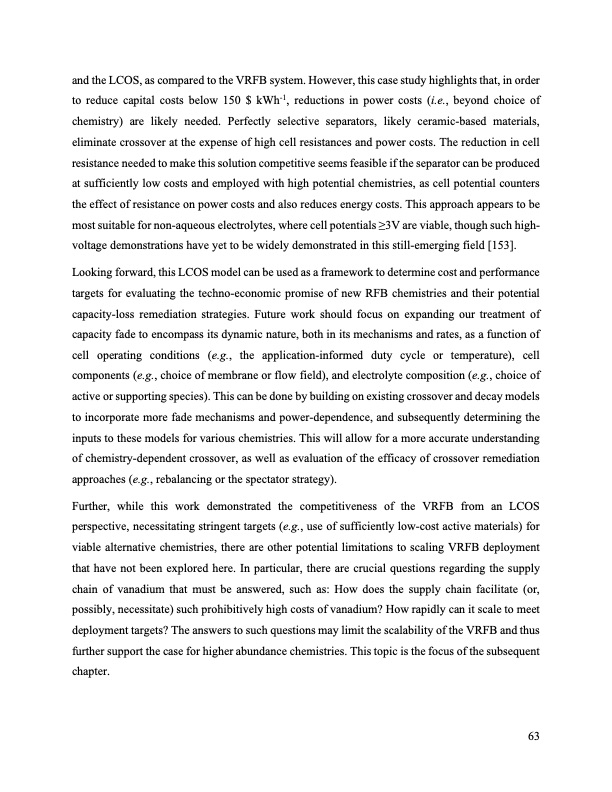
PDF Publication Title:
Text from PDF Page: 063
and the LCOS, as compared to the VRFB system. However, this case study highlights that, in order to reduce capital costs below 150 $ kWh-1, reductions in power costs (i.e., beyond choice of chemistry) are likely needed. Perfectly selective separators, likely ceramic-based materials, eliminate crossover at the expense of high cell resistances and power costs. The reduction in cell resistance needed to make this solution competitive seems feasible if the separator can be produced at sufficiently low costs and employed with high potential chemistries, as cell potential counters the effect of resistance on power costs and also reduces energy costs. This approach appears to be most suitable for non-aqueous electrolytes, where cell potentials ≥3V are viable, though such high- voltage demonstrations have yet to be widely demonstrated in this still-emerging field [153]. Looking forward, this LCOS model can be used as a framework to determine cost and performance targets for evaluating the techno-economic promise of new RFB chemistries and their potential capacity-loss remediation strategies. Future work should focus on expanding our treatment of capacity fade to encompass its dynamic nature, both in its mechanisms and rates, as a function of cell operating conditions (e.g., the application-informed duty cycle or temperature), cell components (e.g., choice of membrane or flow field), and electrolyte composition (e.g., choice of active or supporting species). This can be done by building on existing crossover and decay models to incorporate more fade mechanisms and power-dependence, and subsequently determining the inputs to these models for various chemistries. This will allow for a more accurate understanding of chemistry-dependent crossover, as well as evaluation of the efficacy of crossover remediation approaches (e.g., rebalancing or the spectator strategy). Further, while this work demonstrated the competitiveness of the VRFB from an LCOS perspective, necessitating stringent targets (e.g., use of sufficiently low-cost active materials) for viable alternative chemistries, there are other potential limitations to scaling VRFB deployment that have not been explored here. In particular, there are crucial questions regarding the supply chain of vanadium that must be answered, such as: How does the supply chain facilitate (or, possibly, necessitate) such prohibitively high costs of vanadium? How rapidly can it scale to meet deployment targets? The answers to such questions may limit the scalability of the VRFB and thus further support the case for higher abundance chemistries. This topic is the focus of the subsequent chapter. 63PDF Image | Bringing Redox Flow Batteries to the Grid

PDF Search Title:
Bringing Redox Flow Batteries to the GridOriginal File Name Searched:
Rodby-krodby-phd-chemE-2022-thesis.pdfDIY PDF Search: Google It | Yahoo | Bing
Salgenx Redox Flow Battery Technology: Salt water flow battery technology with low cost and great energy density that can be used for power storage and thermal storage. Let us de-risk your production using our license. Our aqueous flow battery is less cost than Tesla Megapack and available faster. Redox flow battery. No membrane needed like with Vanadium, or Bromine. Salgenx flow battery
| CONTACT TEL: 608-238-6001 Email: greg@salgenx.com | RSS | AMP |